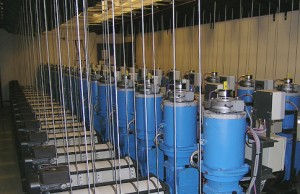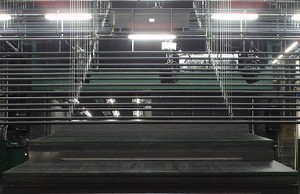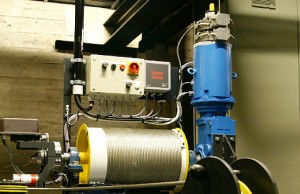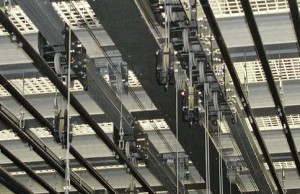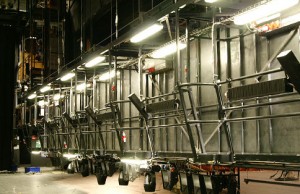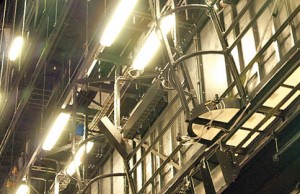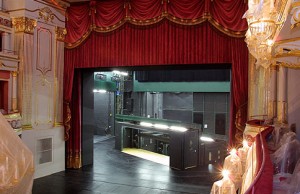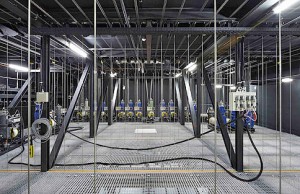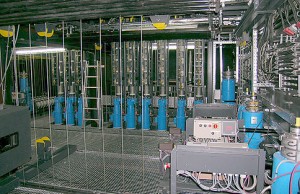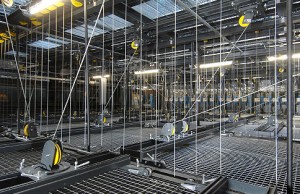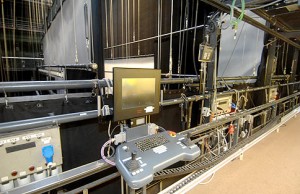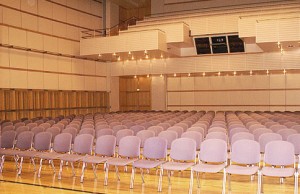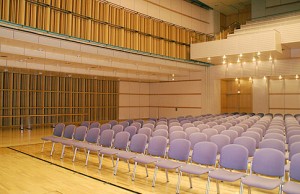Flybar Drives
A flybar drive is a lifting device with several steel wires, which is used for lifting of decoration, lights etc. In most cases the load is taken by a bar or traverse. A flybar drive can be designed as a winch (all wires are wound on a single drum) or as a tubular shaft drive (each wire is wound on an own drum). On the winches, the grooved drum can be arranged in a vertical or horizontal position depending on the requirements and the available space.
Besides motor driven flybars also manually moved flybars are used. There are handwinches and fly facilities with counterweights (DIN 56921-1) where most of the moveable load is balanced by counter weights. We design the fly facilities according to your demands and the technical specification for each individual application.
Since a flybar is used to move and hold loads over persons, or to transport a person higher safety regulations have to be met. In Germany these regulations are described in the rules for accident prevention BGV-C1 and DIN 56950. Employees of our company are actively involved in formulating these rules. A new european safety standard which was developed with our involvement during a CEN-Workshop has been presented to the public for discussion.
Point Hoist
Basically point hoists are built like flybars, except that it is only supplied with one steelwire to move point loads.
Point hoist may be installed statically or be designed for mobile use, in order to place the hoist on different points on the flyloft. On statically installed point hoists very often the downfeed point of the wire can be moved in order to use the hoist more fexible.
There are also hoists with chains or steelbands instead of steel wires, but these are not in our product range. If desired, we are able to adapt third party products to complete the system to your demands.
Portal Systems
Portal systems are steel constructions which build the viewframe from the auditorium to the stage. On the stageside they are designed to hold light systems. Portalsystems can partly be entered and consist of towers or screens on the sides as well as horizontal bridges and screens. Parts of the horizontal and vertical elements are driven by machines or can be moved manually in oder to change the height and width of the viewframe.
Fly & Pulley Lofts
In most cases the flyloft is an accessable steel construction above the stage area. It is used to hold the machines of the upper machinery – flybars and point hoists as well as the pulleyblocks are installed here.
For better accessibility of the flyloft, which is also an advantage for movable point hoists, the pulleys are installed on a steel construction above the flyloft, the so called pulleyloft.
Working Galleries
Working galleries are accessible steel constructions on the walls of the stage tower which are normally arranged on several levels. Mainly they are used for attaching lightning gear but they also can take up control desks for operating the stage machinery.
The guard rail on the stage side is designed to easily attach spotlights and other lightning equipment. (“Spotlightrail”)
Lifteable Gates and Walls
Liftable gates and walls can be found on the stage as well as in the audience area. At the audience area, vertically moveable walls can be used to for example combine several small areas to one big hall.
At the stage, lifteable gates seperate the main stage from the side and backstages. These gates can be designed to act also as a sound damping wall or as a fire security gate between the different stage areas. In this case the design and the moving system satisfy the demands of an iron curtain.
Curtain Systems
On a classical stage, a curtain at the portal zone, shuts off the audience from the stage area. The curtain is attached to a rail system. The construction of this system depends on the dimensions and the weight of the curtain. The curtain can be opened and closed manually or motor driven. The curtain can be opened from the middle to the sides (“Greek curtain”) or may be lifted up (“German curtain”). Other versions are shirred- or Wagnercurtains.


